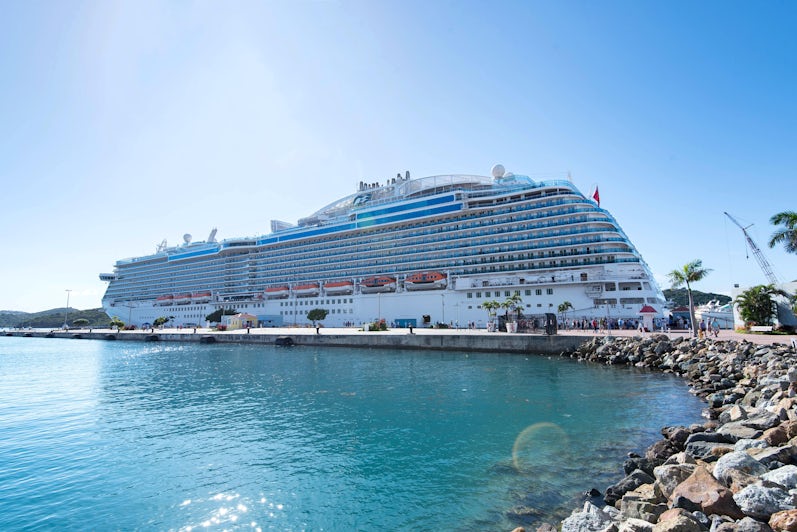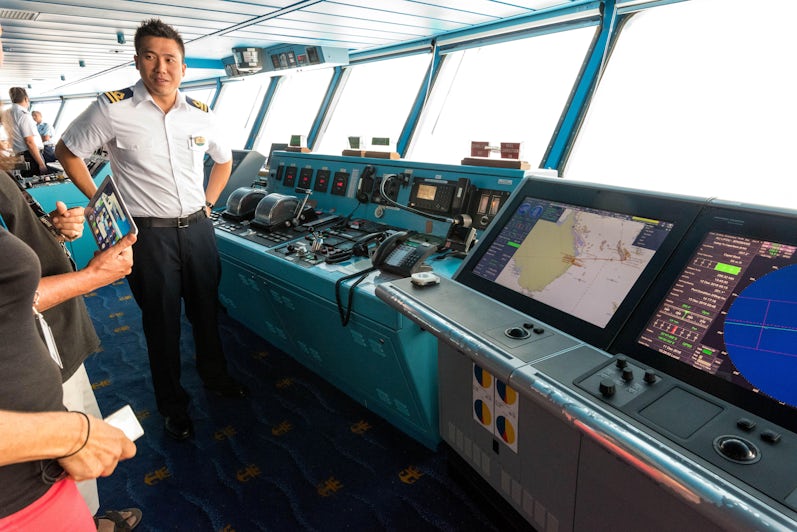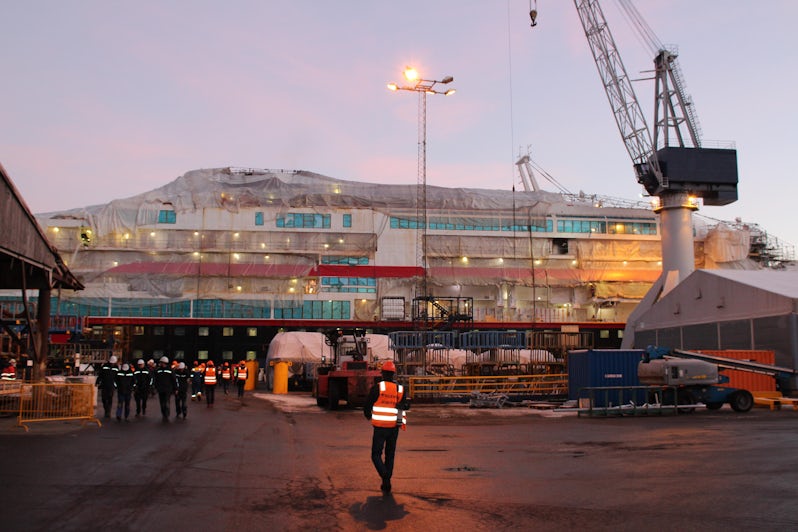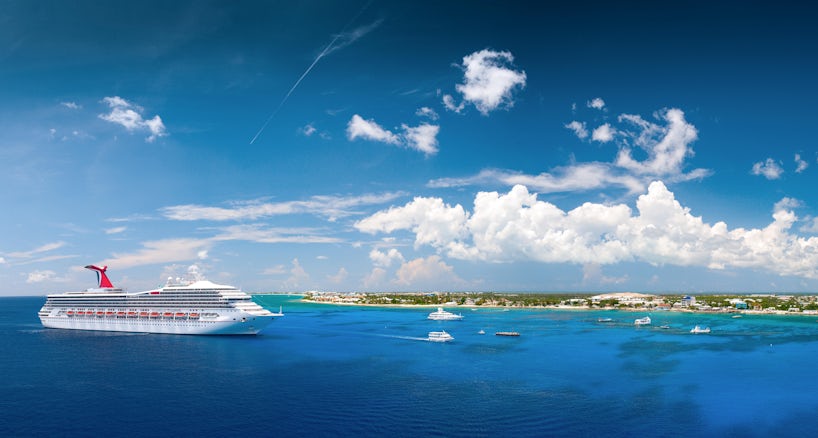
How Do Cruise Ships Work?


Editor's Note: This piece was written by Ben Lyons, who attended the U.S. Merchant Marine Academy, and worked on a variety of cargo and passenger ships, including cruise ships in Hawaii and Dynamic Positioning equipped cable ships. In 2003, he became the first American officer hired by Cunard in over 160 years. After five years on QM2, Lyons left to join Lindblad Expeditions as chief officer (and more recently captain) of National Geographic Explorer in Antarctica and the Arctic. Lyons is currently CEO of EYOS Expeditions, which offers superyacht expeditions.
Sitting contentedly on deck, listening to the hushed splash of the sea as it washes along the side of the hull, you would be forgiven if you forget you are on a monster of engineering. At that very moment, deep in the bowels of the ship, small armies of engineers (and an awful lot of computers) are working to keep the lights on, the air conditioning cooling, the toilets flushing and the propellers turning.
A character in John Irving's "The World According to Garp" felt that she "had grown up on a large ship without having seen, much less understood, the engine room." Unless you're one of the few who eagerly (and almost always unsuccessfully) attempts to get an engine room tour on every cruise, most of us don't give much thought to what goes on below the passenger decks. Yet widely publicized events like the Carnival Triumph engine room fire in 2013 have provoked both anxiety and curiosity about how these ships are powered.
To quell your fears and satisfy your quest for knowledge, we have set out to shed some light on the sometimes murky subject of how cruise ships work -- no engineering degree required.
On This Page
Engine Room
Possibly the most basic detail to understand about the engine room is its location. Because ships need their heaviest weights located as low as possible for stability, engines are usually mounted just above the keel. The lowest decks of the ship are almost entirely devoted to machinery.
As you'd expect, an area that creates enough power to drive a skyscraper-sized vessel through the water is large -- and engine rooms are often at least three decks high. But because space is at a premium on cruise ships, engine rooms might not be the vast, cavernous space you envision. Rather than a long, continuous hall stretching the length of the hull, machinery is divided into smaller watertight compartments. One area might contain the main engines; another compartment might house the air conditioning system.
Compartmentalization is done for safety. In case of fire or a penetration to the hull, multiple compartments help to contain the damage.
In exceptionally rare instances, engines may be placed somewhere other than the very bottom of the ship; on Cunard's Queen Mary 2, the four diesel main engines are located above the keel. However, its two smaller, lighter gas turbines are located at the very top of the ship directly aft of the funnel.
An interesting side note: Decades ago, it was not uncommon for older liners to have two engine rooms. Technology gradually allowed engine spaces to be consolidated. However, legislation now requires ships to have duplication of equipment and two engine room spaces.

Getting the Terminology Straight
Before we go further, let's agree on some basic terminology as the technical vocabulary can be a bit confusing. For the purpose of this article, "main engines" refer to those engines that produce the vast power to move the ship. On conventional, or direct drive, diesel vessels, these engines are connected to the propeller shaft; on diesel electric ships, the main engines are connected to the main generators.
Furthermore, "engine" and "motor" are not interchangeable. Engines rely on fuel and ignition and can help generate electricity. Motors rely on electricity to make something move. Propulsion motors, therefore, take the electricity produced by the engines and use it to make the propellers turn.
Conventional Diesel
Despite the colloquialism of "steaming to St. Thomas," the days of steam engines in ships have all but disappeared. (The last passenger ship built with a steam engine -- Sitmar's FairSky in 1984 – was scrapped in 2013.) Today, diesel engines are the standard.
So, how do diesel engines work? Think back to old ships like the Titanic. Steam pressure in chambers pushed pistons up and down. The pistons were connected to a crankshaft, which turned the vertical motion of the pistons into a rotational movement. The crankshaft was directly connected to the propeller through a long propeller shaft. The faster the pistons on the engine moved up and down, the faster the propeller shaft turned and the faster the ship went.
On some smaller and midsize ships, such as National Geographic Explorer or Windstar's Star Breeze, Legend and Pride, the concept has not changed dramatically. The mechanics are the same; the main difference is how the power is created. Instead of steam making the pistons go up and down, the ignition of fuel now creates pressure and pushes the pistons up and down, turning the crankshaft connected to a propeller shaft.
Because the engines are usually turning a crankshaft at a very high rate of speed (often hundreds or thousands of revolutions per minute), the engine is connected to the propellers through gears. Propellers are designed to turn much more slowly -- usually 250 revolutions per minute or less. The gearing allows the engine to turn at its faster, more efficient speed, while allowing propellers to turn at their slower, and also more efficient, speed.
One advantage that today's "direct drive" diesels have is the option of using a shaft generator, a device that uses the circular motion of the propeller shaft to generate electricity for hotel services like lighting and cooking. Of course, these shaft generators can only be used when the ship is moving at sea with a fairly constant speed; if the propeller shaft isn't turning, then neither is the generator, and no electricity can be produced.
Even though many ships are still built with conventional diesel plans, almost all new cruise ships (such as Celebrity's Edge Class or Carnival Horizon) feature some form of "diesel electric" propulsion. On these ships, the main engines aren't connected to the propeller shafts; instead, the main engines are directly connected to large generators with one job: producing electricity.
The electricity they produce is sent to electric motors, which then power and turn the propellers. Often, there are many comparatively smaller engines that make up the power demand for the ship; in port, only one engine may be online, but out at sea at full speed, they may all be online.
The primary advantage of diesel electric systems is efficiency; they allow the engines to operate near their most efficient settings regardless of whether the ship is moving at 5 knots or 20 knots.
New Technology for the Environment

However, new technology and research is driving even greater efficiencies and more environmentally friendly ships. Almost 20 cruise ships will soon be in service powered by Liquified Natural Gas, or LNG; the first, AIDAnova, set sail in December 2018.
LNG-powered ships have engines that are modified to burn natural gas that has been turned into a liquid and kept at a temperature 260 degrees below zero in specially insulated fuel tanks. While the infrastructure in ports to supply LNG is not fully global, the advantages for cruise lines are many -- including reducing nitrogen oxides by up to 80 percent and carbon dioxide emissions by 20 percent.
Hybrid propulsion plants are also gaining popularity. Much like a hybrid car, hybrid ships rely on two different types of power systems. Hurtigruten's Roald Amundsen is perhaps the best known example; the ship has extensive battery packs that will have enough stored power to operate and sail the ship, even with the main diesel engines shut down.
Currently, the batteries have enough power for only 30 minutes of silent, emission-free navigation before the diesel engines are needed again; as the battery technology improves, Hurtigruten expects that time to increase.
Even advances in the underwater hull are helping to make new cruise ships more efficient. Royal Caribbean's Quantum of the Seas, Norwegian Bliss and Celebrity Edge are using thousands of tiny air bubbles underneath the hull to gain more efficiency. The bubbles, pumped out underwater from the bottom of the ship, reduce the surface area of the hull that is in contact with the sea. This thereby reduces friction that slows a ship down and improves its fuel efficiency by up to 10 percent.
It's All About the Power
Losing electrical power on a ship can be devastating. The main engines and even the generators themselves require electricity to keep going. Electrically driven pumps take in cold seawater from the ocean to help cool the engines; electrical pumps take fuel from the fuel tanks and supply it to the engine. Electrical power is critical to many operating functions, and without it, the ship comes to a halt.
Of course, the production of electricity is vital to all aspects of a ship's operation. Large equipment (such as the bow thrusters, or, in the case of diesel electric ships, the actual propulsion motor) requires high-voltage electricity. For smaller machinery, such as lights in your cabin or the equipment in the galley, the electricity goes through a transformer and is stepped down into a more useable, lower voltage -- such as 110V.
To distribute the electrical power, large cables snake through the ship. Hundreds of miles of cables carry power from the generators to switchboards and eventually through passageways, cabins and public rooms.
Cabling can be a weak point in a ship's distribution system. Even ships with two engine rooms can suffer power failure if the electrical cables are not truly redundant. For instance, if two main engines in different engine rooms produce power that goes into a single cable that brings power to the propulsion motors, a problem to that electrical cable would cut off all propulsion power.
Consider it like a highway: If an accident closes the road, traffic (i.e., electricity) won't move anywhere unless there is a detour or a second route that can provide another way around the accident.
Portside Power
When ships are docked and not moving, main engines and generators produce far more power than needed. In port, they are turned off, and smaller generators are used to supply the "hotel" load (i.e., lights, air conditioning, the galleys, etc.). Moving the ship through the water takes up the vast majority of a ship's need for power -- somewhere in the vicinity of 85 percent of the power a diesel electric plant produces goes to the propeller. The rest goes toward keeping the lights on and the passengers and crew comfortable.
This helps explain why hotel functions can sometimes be restored even if the ship's propulsion is not working -- separate generators provide power that does not go toward moving the ship. (However, if a fire knocks out the wiring that supplies the electricity, having a separate generator won't make any difference.)
Today, more and more ports (and ships) are being fitted with systems that allow a ship to literally "plug in" to a local shoreside electric grid when docked. The ship's engines can be turned off, which helps reduce emission and pollution.
Emergency Generators
So what happens when things go wrong and the ship is dead in the water? All ships have an emergency generator to maintain vital electrical power.
These backup generators are always located higher up and outside the engine room spaces to insulate them from fire or damage to the engine room. Big ships require so much power that they might have two or more emergency generators. Even so, they will not have anywhere near the capacity of the main engines and generators. They don't produce enough electricity to move the ship, and they can't even supply all the limited power needed in port, mostly because of space constraints.
Thus, the emergency generator is instead used only for very essential navigation systems -- crucial bridge and communication equipment, a few critical pumps in the engine room (such as the pumps that supply fuel to the engines) and emergency lighting. (Cruise ship emergency lighting is generally pretty good. You can recognize which lights are operational on the emergency switchboard because there will be a little red dot next to the light. On your next cruise, take a look as you walk down the passageways and look for the red dots -- you might be surprised how many lights are powered in an emergency.)
Should the emergency generator also fail, ships are required to have -- and we're not making this up -- a battery backup. Battery rooms provide at least 24 hours of power to an even smaller list of emergency equipment. However, the essential systems they supply are so limited, they cannot power many hotel services and are certainly not enough to move the ship.
Safe Return to Port

So, what is being done to ensure incidents like the 2013 Carnival Triumph stranding don't happen again? Plenty, actually.
Until recently, emergency power supplies were not powerful enough to cover "nonessential" items, like air conditioning, which is one of the biggest power draws of the hotel load. (That isn't likely to change in the foreseeable future. It may be uncomfortable to be hot and sticky on a ship, but it isn't unsafe.)
Nor were the vacuum pumps needed for the toilets considered "emergency equipment." However, International Maritime Organization regulations entitled "Safe Return to Port" came into effect for all passenger ships longer than 120 meters (393 feet) built after 2010. Recognizing that increasing passenger capacity makes it harder to evacuate large ships, these regulations are designed to ensure that in the case of a fire or other incident, there are enough redundancies so that passengers can stay safe onboard longer -- and have basic services.
The regulations require full redundancies -- including two engine rooms and the doubling up of cables and electrical systems that snake throughout ships. This means that even if a fire destroys one main engine room and the generators that supply the power to move the ship, a separate engine room with enough power to propel the ship would still be operational.
Although the ship would not be able to travel at normal speed, it would be able to navigate without the assistance of tugboats. Even more groundbreaking are the designations for providing basic services -- including specifications for one workable toilet for every 50 people.
In the aftermath of the Carnival Triumph fire, Carnival Cruise Line announced steps that exceeded the "Safe Return to Port" regulations. Every one of its ships was involved in a fleetwide $300 million retrofit and received an additional emergency generator to power 100 percent of stateroom and public toilets, fresh water and elevators.
In a follow-up phase, Carnival installed a second permanent backup power system on each ship to provide greater hotel services in case of a power failure, including additional cooking facilities, cold food storage and even internet and telephone communications.
While no regulation can cover every eventuality, these changes will certainly go a long way to ensuring power losses are even more unlikely… and that we can spend more time contentedly enjoying being at sea without having to wonder how cruise ships work.